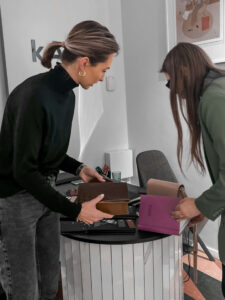Indrė Sapagovaitė-Briedelienė is a famous etiquette expert and lecturer, who teaches the intricacies of modern-day etiquette to her large group of followers on Instagram. Her teachings encompass not only the correct storage of tools and dress code advice, but also self-confidence, respect for others and practical tips to make our daily routine easier.
Indrė stresses that etiquette is not about pointing fingers at broken rules but rather about fostering more careful self-knowledge in a rapidly changing world. In this interview, we dig deeper into what etiquette says about handbags – which hand is appropriate to carry a handbag or how to distinguish between modern etiquette guidelines and outdated superstitions. The interview took place at the kARTu studio in Kaunas, surrounded by a vibrant array of handmade accessories, with kARTu’s creative director, Ingrida Jasinskė, conducting the interview.

Indre, could you briefly explain the meaning of etiquette in everyday life and how it can be useful in everyday situations?
Often, we think of etiquette as only being relevant for special occasions when we attend celebrations and want to learn about proper behavior. However, in reality, etiquette is even more important in our everyday lives because it encompasses simple communication and interacting with other people, which is the most essential aspect of etiquette. It is crucial because it can help others around us feel better.
Can we equate etiquette with respect?
Absolutely. The definition of etiquette is closely linked with the concept of ‘respect for others.’ I like to describe it as a unique and straightforward tool that helps you achieve your goals, enhances your self-confidence and improves relationships, both in the workplace and in your personal life.
Are there etiquette trends, fashions? Do they have a cycle?
Maybe cycles change depending on how old we are. What is important in adolescence will be less relevant in adulthood. When business meetings, events and celebrations begin, more rules immediately appear. Also, the adult world’s respect for the time given and received contributes.
Today we are talking to kARTu fashion house. In the fashion sphere, trends are influenced by high fashion creators, social network movements and opinion makers. Does the media influence etiquette?
Social media certainly contributes to bringing issues to the surface. When public conflicts occur and when faced with unprecedented situations, people have questions – how should they act, what should they say, how should they react? Therefore, the media does not create or correct the label, but only emphasizes certain areas of it.
So who makes the rules of etiquette and who breaks them?
It is clear that the rules of etiquette from the time of Versailles are no longer relevant today, as they have evolved along with the way we live. A good example of this is when we started communicating remotely after the pandemic started, the rules of remote communication etiquette emerged very quickly.
Dress code and handbags: where and how much freedom do we have in combining these two elements without breaking the rules of etiquette?
Etiquette has specific rules for dress codes, but in this case, women generally have more flexibility than men. The size and type of handbag to carry, depend on the occasion and venue. Small handbags are typically appropriate for formal events and gala dinners. However, if you feel comfortable doing so, you can incorporate a backpack into your business attire. In everyday style, the size and type of handbag does not matter.

As for everyday style: how can the rules of etiquette be applied to a real, down-to-earth woman who drives a bus, raises children and pursues her professional career?
I like this question because etiquette is not limited to a specific social group, but rather it is for everyone. These are everyday tips on behavior that does not depend on one’s lifestyle.
You mentioned behavior tips, so let’s talk about different types of accessories and how to wear them. According to etiquette, which hand should a backpack or purse be held in?
There are no restrictions on which hand to use, as left-handed and right-handed people will typically use their dominant hand for holding accessories. However, advice may be given in situations such as meetings or events, where it is better to hold the handbag in the left hand, leaving the right hand free for greeting and handshaking.
What are the intricacies of handheld carrying?
First of all, it’s about holding the bag correctly. It should not be held too close to the armpit. If it doesn’t have a strap, then it’s better to hold it in the palm of your hand or press it against your torso with your elbow. When sitting, you can put it on the chair behind or to the side. If the chair has an open support or the armrests have holes, then you can put the bag on your lap.
What about larger handbags? Where to put it during the meeting?
Larger handbags can be placed on the nearby chair or special hooks for handbags. In Lithuania, we have the luxury of space in restaurants and cafes, so you can ask for an extra chair. If there is no other choice, the handbag can be hung on the backrest. Better on the back than on the ground, but not much better (laughing).
One gets the impression that it is easy to surround etiquette with myths and non-existent rules. Where do these myths come from?
These myths often arise from confusion between etiquette, superstitions, customs and cultural traditions. They are perpetuated through generations and formed from beliefs that are not rooted in historical or logical facts. For example, a myth such as not putting your handbag on the ground because it will cause you to lose money, is simply a superstition and not a rule of etiquette.
Is that possible?
In this belief, the etiquette part is just “don’t put your purse on the floor” and the rest is superstition.

We have found more beliefs related to handbags, such as: ‘The way you handle your handbag says a lot about you. Not only your personality, but also your good manners. Do you believe this statement to be true?
In fact, knowing the rules of etiquette and observing how a woman handles her handbag can indicate her level of etiquette knowledge. Of course, the handbag itself may provide some hints about the woman’s personality. In this case, we are referring to the order of the bag, its condition, how it is carried, how it fits with the rest of the outfit and how it is treated.
How about this one? ‘You can tell a lot about a man by his shoes, and a lot about a woman by her handbag’.
I would partially agree with this connection because, in my teenage years, I used to judge men based on their shoes. However, this is just a superstition and not a rule of etiquette. While the etiquette theory includes recommendations for taking care of one’s possessions, such as keeping them clean, in good condition and neat, associating men with shoes and women with handbags is purely a superstition.
Are there different tips for wearing accessories for women and men?
The types of accessories that women and men wear are different, so the rules for each are slightly different. Men often choose briefcases, backpacks or pockets. (laughs)
So what about men’s pockets full of stuff?
Full pockets are not good, especially when the amount of stuff makes the jeans dirty and it becomes evident which pocket holds the wallet and which holds the phone.
Going back to the myths, we also found this one: ‘You can’t leave an open handbag in plain sight’. Is this really a myth?
In the world of etiquette, all hygiene rituals should take place in private, such as applying lipstick, combing hair and cleaning shoes. The same applies to personal items: the less visible they are, the better.
And finally, what about the belief that leaving a bag or purse on the table can cause conflict, illness or trouble? While this belief may have originated as a superstition, it does have some basis in etiquette.
According to etiquette, personal items, including bags, phones, glasses and keys, should not be placed on any table. Despite this, it’s common to see such photos on social networks with a bag, glasses and a cup of coffee on the table with a picturesque background. However, it’s important to remember that, according to etiquette, this is not the correct way to handle personal items.
Perhaps taking photos like that is a way to create a better impression of oneself. However, etiquette rules do not oblige one to choose more expensive items. We still often see people trying to look more stylish or luxurious by buying fake items.
Etiquette rules do not concern themselves with the price or label of an item, but rather its quality and appearance. Items should be well-maintained, made of good material and not torn. There are no specific instructions regarding fake items or people wearing them. However, it is important to remember that using fake items is a form of disrespect towards the original creator’s work and copyright.


